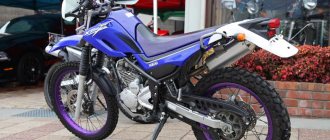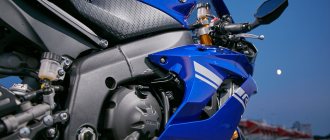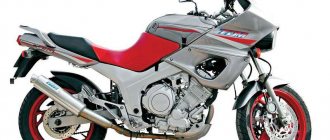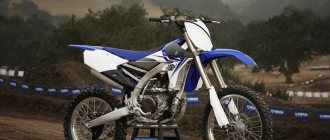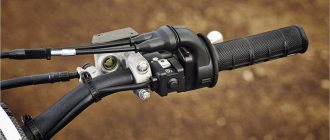The Yamaha YZF R3 model, sales of which started in 2015, became the concern's response to the Kawasaki Ninja 300 motorcycle, which appeared on the market a couple of years earlier.
The budget price, small engine volume, which, nevertheless, is more powerful than that of its competitor, played a role in the popularity of the model.
At the same time, managers especially emphasize that when creating the motorcycle, developments were used that were previously used only on top versions.
Specifications
The main difference from Kawasaki was the slightly larger engine, which had a positive effect on all parameters of the bike. This is a standard 4-stroke engine with 2 in-line cylinders.
The engine provides good dynamics at low and medium speeds, as well as good potential at high speeds.
- Working volume - 321 cm3.
- Power - 42 hp
- Number of valves - 8 (4 per cylinder).
- Cooling is liquid.
- Fuel supply - injector.
- Ignition is electronic.
- Start - electric starter.
- Tank volume - 14 l (including 3 l reserve).
Transmission and clutch
The main drive is a classic chain.
The only nod to modern bikes was the 6-speed gearbox.
Users noted that the gear ratios are selected so that you can drive around the city in first gear. The five others are only for “rocket guys”, which is probably why they are shifted to the very end of the rev range.
- Clutch - multi-disc , oil bath, power transmission - cable .
- The main drive is a chain .
Brakes
Front brakes.
Rear brakes.
Although one would expect drums to be installed on a budget bike, the brakes are nevertheless modern. Hydraulic disc rotors
Front brakes
- Number of disks - 2.
- Diameter - 298 mm.
- Support - 2-piston.
Rear brakes
- Number of disks - 1.
- Diameter - 220 mm.
- Support - 1-piston.
ABS is installed as standard. Such models are labeled YZF-R3A . In American markets you can see the YZF-R3. They are produced to order from American dealers and do not have ABS.
Chassis and brakes
The disc brakes here are sufficient: the disc diameter is 220 mm at the rear and 298 mm at the front. The front telescopic fork has 130mm of travel, while the monoshock swingarm has 5mm less travel. In general, the exterior looks quite elegant, but does not shine with special luxury or individuality.
Driving performance
The maximum speed indicated in the documents is 175 km/h . Users who managed to “touch” the new model claim that this is an advertisement.
175 km/h from a hill and with a tailwind. In other conditions the motor will not pull.
Acceleration to hundreds
Acceleration from zero to 100 km/h is also not impressive - 6.5 seconds .
Fuel consumption
If you do not keep the tachometer needle in the red zone, it seems as if the motorcycle is not consuming fuel at all.
Fuel consumption with an average cruiser and a good flat road is 3.8 liters . Mixed - up to 5 l . The specific one depends on the conditions of use.
Yamaha YZF-R7 2022 On the Go
In short - fun. Like its touring brother, the Tenere 700, the Yamaha YZF-R7 is a simple motorcycle in the best possible way. Here's the engine, here's the throttle - and that's it: no riding modes for you, no electronic nannies (except ABS), just you and the motorcycle. And it's great.
This motorcycle also had an optional quickshifter, but it only works up and only with the standard gear arrangement (sorry, fans of reverse shifting).
The test site stretches for more than 3 kilometers in a straight line. There are steep elevation changes, long turns, blind entrances, and a couple of rather severe braking zones - in short, an ideal place to test a sportbike. The R7's 75 horsepower engine doesn't come close to the R6's 118 horsepower, but for most riders, it's all about how that power is distributed across the rev range. The high-torque midranges on the R7 are easily accessible, and the use of a quickshifter allows you to really get the most out of the engine even without particularly honed skills. This character of the motorcycle is good for experienced riders, but it is even better suited for beginners who have switched from a younger model - they will not have to rev the engine to the traditional (for sport bikes) 10,000 in order to at least ride.
First down, I open the gas, release the clutch - more gas, let's go, GO! There’s not a single thought in my head, just sensations: light, nimble, simple... Steering on the Yamaha YZF-R7 couldn’t be simpler, it shifts from side to side with the speed you’d expect from a small-capacity car like the R3 or other small thing. It's amazing how the small geometry changes Yamaha has made make the bike feel more nimble. When leaning, you can clearly feel how much more confident and rigid it is than the MT-07: it is more stable, the feedback is clearer, the suspension provides more support. However, the spinal frame has its own characteristics and limitations, and not everyone will like them.
However, the Yamaha YZF-R7 is a wonderful motorcycle that is easy and fun to ride. In the modern world with its electronic wonders, knowing that the right wrist is clearly connected to the traction on the wheel is refreshing and invigorating. Moreover, the traction is just what you need - without going overboard, but also without the need to overclock the engine or switch in any special way. The last section of the track consists of a long series of corners that can be negotiated at full throttle in fifth or even sixth gear with good technique. On the R7 this inspires and pleases, but on something more evil it will simply scare you - in a word, the R7 allows you to drive perfectly with good technology, and hone it without much risk if it is not yet very good. The seating position is surprisingly comfortable, considering how narrow the motorcycle is, and with its 175 it fits perfectly behind the “force field” of the windshield, almost not reaching your elbows with your knees.
Dimensions and weight
Fully filled with all fluids and ready for a ride, the bike weighs 169 kg . Dry weight - 150 kg .
Dimensions, as for a small-capacity vehicle, are within the bounds of decency.
- Length - 2,091 mm .
- Width: 721 mm .
- Height - 1,136 mm .
- Seat height - 779 mm .
- Wheelbase - 1,382 mm .
- Ground clearance - 160 mm .
For whom is it intended?
The main users of this motorcycle are beginners with aesthetic needs.
Based on the statement of company representatives that the bike is planned for sales on all continents and in all countries, we can conclude that it was intended for a person of average and tall height .
However, the position of the mirrors and the saddle for the driver clearly indicate that it is better for a tall biker to look for another model.
Modifications
According to the designers, the model was supposed to be better than the development from Kawasaki. The goal has been achieved, no modifications are planned .
However, in 2016, the concern launched the Yamaha MT-0 3, a naked bike for beginners. It is based on the YZF R3.
Competitors (Comparison)
Kawasaki Ninja 300.
Honda CBR300R.
As the developers themselves admit, they had one main competitor - Kawasaki Ninja 300 . Considering that the model is no longer produced, this can be considered a recognition that Yamaha is still better.
But to complete the picture, here are a few numbers.
| Yamaha YZF R3 | Kawasaki Ninja 300 | Honda CBR300R |
| 2-cylinder | 2-cylinder | 1 cylinder |
| injector | injector (our own development) | injector (our own development) |
| 321 cm³ | 296 cm³ | 286 cm³ |
| 42 hp | 38 hp | 31 hp |
| ABS (optional) | ABS (optional) | combi-break. |
As expected, the YZF R3 was superior in every way compared to the Kawasaki.
Honda's low performance largely depended on the fact that for a long time it assembled small-capacity cars on 1 cylinder , putting speed at the expense of safety and ease of maintenance.
Hello everyone, MotoZak is in touch as always! Those who subscribe to the channel and regularly watch my videos know that I purchased a new Yamaha R3 (now “Mukha”, and you’ll find out why in the video) for the track, but before the first training sessions at the karting track you need to properly break in the engine, as recommended by myself manufacturer. And after a couple of weeks of daily use of this baby, I formed my first impressions, which I will now share!
And according to tradition, the text version (without inserts with jokes, so I recommend watching all of them and the video) The first thing I would like to note and what makes the Erka stand out is the appearance of the motorcycle. If you don’t pay attention to the Izhevsk turn signals, the front part looks very bold and modern, so few people realize that this is just a 300, and comparing it with the Chernysh (Honda CBR600RR) you can feel a big difference between them. It immediately becomes clear which is the 2010 and which is the 2022. The Erka is especially good at night, when all that remains is an angry squint, but if you evaluate it from the side or rear, then the compact engine, the exhaust sound, the bicycle wheels and the entire rear end give it away and say, that this is far from P1 or even P6. Although this did not stop me from receiving attention from the fair sex, so guys who buy a motorcycle just for girls, this bike is just for you and you won’t have to spend much. In general, I was satisfied with the ergonomics of the bike, with the exception of the emergency lights. If you, like me, are used to holding on to the edges of the clip-ons, then you need to try very hard to use the emergency lights while moving, because at the same time holding the gas open and reaching for the button with your thumb is completely inconvenient. Therefore, if the P3 rider did not say thank you on the road, then he simply could not reach the button to turn on the emergency lights. The display, even in sunny weather, does not glare and shows information normally; in addition, it is quite informative and you can find out what your average fuel consumption is, turn on the economizer mode, check the mileage after the last oil change, daily mileage, gear indicator and control lamps - oil pressure , abs, neutral light and blipper, which signals that it’s time to upshift. On P3 models from 1919 onwards, the blipper is customizable, it has several visual operating modes - blinking, on and off. You can also select the speed range at which it will operate. I liked all these features, they are useful and convenient. When I took the motorcycle, the fuel consumption was 3.9, and now in the run-in mode it has dropped to 3.6 liters, which is not at all bad. The gas handle has a long stroke and turns very easily, unlike Chernysh. I still find it more pleasant when the throttle opening is tighter and some kind of resistance is felt, and not like fluff. Otherwise, I didn’t find any know-how, everything is the same as on a regular motorcycle, a cable clutch and a regular brake machine with stock levers, which are comfortable. Go ahead. The sound of a motorcycle with a stock can is quiet, only at higher speeds does the parody of the Erka begin. Now I’ve already bought a new jar, but the transformation series will be separate, so subscribe so you don’t miss it. Now about the motorcycle review. Due to the mirrors, in principle, everything is clearly visible, but as soon as the traffic jam starts, the drive becomes uncomfortable due to their flight. It’s good that the Japanese made them foldable and because of this I can actually climb everywhere with ease, and sometimes I even push the sports in front. That’s why they came up with the nickname “Fly” for the erke, who is just as annoying, nimble and fast. By the way, this baby with a light pilot accelerated to 190 km/h, but if we talk about acceleration dynamics, of course it’s not there compared to 600. But in city traffic I didn’t feel disadvantaged. Yes, powerful motorcycles leave traffic lights faster, but then! At the next traffic light I arrive when the signal is green and we drive together again. On the track, in order for the motorcycle to have a good return, it needs to be kept at high speeds and in this riding mode there is quite a strong vibration on the clip-ons, after which the hands begin to itch and get tired. Of course I didn't like this. But the landing on the P3 is very comfortable, you can just ride and ride without getting tired, after using it for a week, when I switched to Chernysh, I realized what a shrimp landing is, although I don’t get tired on the CBR, but the fact remains that on the P3 moving around is even more convenient and comfortable. Due to its low weight, the motorcycle is very sharp and easy to control; you literally move your body a little into the turn and the motorcycle immediately falls into it. I love it when there is such a sharp feedback, but there is another side to the coin... If we are talking about serious angles of inclination of the motorcycle, then any body movement is transmitted to the bike and plays a role in control, so you need to get used to the smoothness of your actions. Do everything quickly, but not abruptly. The motorcycle brakes normally when stock, the ABS even kicked in a couple of times, which is new to me, but definitely a useful thing for novice pilots. I also had time to tinker with the bike a little and pay more attention to the details. I liked that you don’t need to remove the plastic to change the oil; this is a big plus, but otherwise, of course, you can see the savings in my opinion. Everything looks kind of flimsy. If you look at the running boards, the gearbox foot, the brakes, it seems like they are about to break or the metal is bent. I didn’t appreciate the chain tensioning mechanism either, when you loosen the bolts, you start chattering, I don’t know, maybe this is already the norm, but after SBR it seems to me like some kind of Chinese thing. Also with the rear axle, could it be possible to make some kind of clamp? You have to press the wrench against the slide on the other side to unscrew the nut completely. I also have a question about switching speeds from 1st to 2nd, if this is done at low speeds, so as not to strain the engine, so to speak, then quite often the gear is not engaged, so you have to turn it in first gear for at least 6 thousand... Owners of eroks, write is this the norm? In general, these are my first such minor quibbles, but we’ll see what else we’ll have to deal with when we start tuning and preparing for the track. Now let me give you a short summary. I think this motorcycle is, first of all, perfect for a novice girl pilot, the motorcycle is smooth, light, comfortable and does not provoke racing and aggressive riding, but on the other hand, it will quickly get boring with its boredom and if you are a passionate person who loves speed, then you definitely need something more dynamic. Personally, I started my motorcycling career with the SBR600RR and quite normally continue this path, but again, if you know how to control your emotions and are friends with your head, well, nothing can save the crazy ones. I would also take this bike for a daily ride to work or for small errands, generally an excellent option. He eats little, fits everywhere and looks great. These are my first impressions of Mukha, let’s see how she performs on the track! Good luck to everyone, MotoZak is always in touch!
Flaws
- Dynamics.
- Price.
- Normal traction is only in the red zone.
and dignity
This is perhaps one of the best lightweight sports bikes for daily use.
- Low center of gravity.
- The ability to sit not only in a sporty way.
- Maneuverability.
- Compactness.
- Convenient, clear instrument panel.

